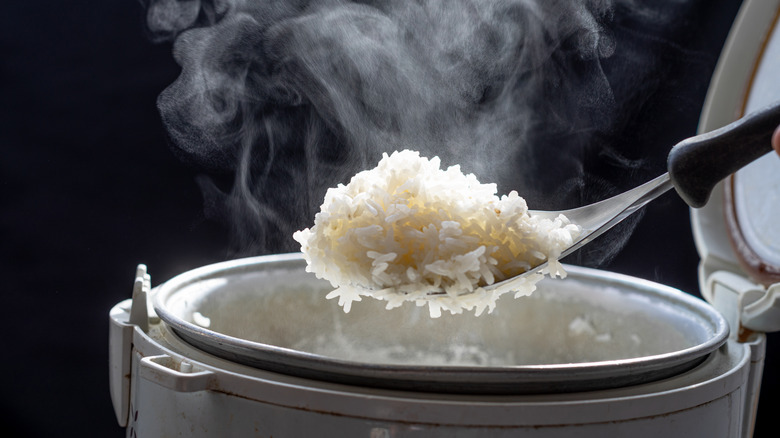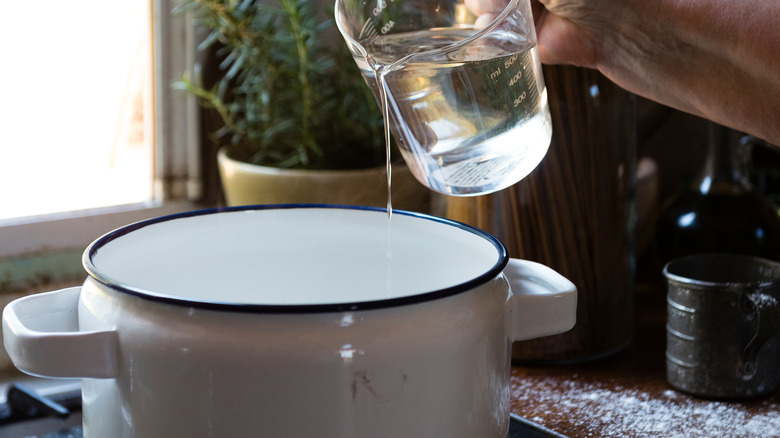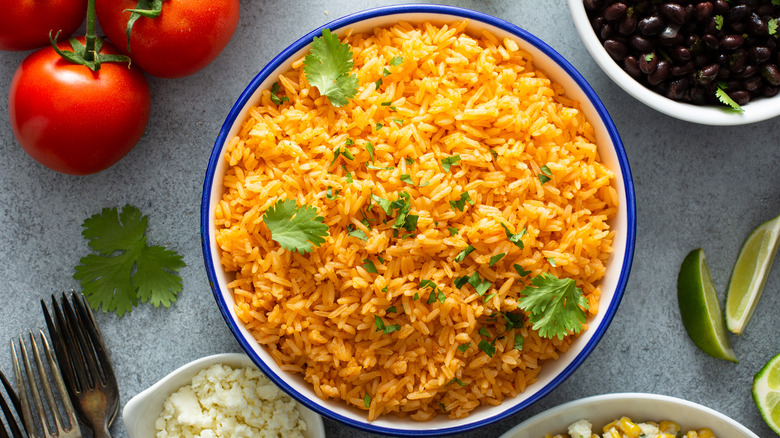Save Overly Sticky Rice With A Splash Of Vinegar
If you've ever boiled rice in a pot or rice cooker only to find it's developed a gummy, cohesive texture, rest assured you're not alone. But with the right rice know-how, it's possible to keep your rice nice and fluffy. One way to prevent a sticky situation is to add a splash of vinegar to your rice as it cooks.
It's common practice to add a pat of butter, oil, or salt to boiling water before you toss the rice in to add flavor — but a small amount of vinegar works its acidic magic to strip some of the starchy excess from kernels of rice as they cook. Similar to the effect of rinsing rice under water to remove extra starchy carbs from the grains, the acidic and corrosive nature of vinegar lends a hand to wash the kernels and allow the grains to better take up water, without becoming overly dense or sticky to the bite.
Vinegar is used as a common seasoning to impart flavor for sushi rice or rice bowls, added with sugar and salt after short-grain rice has been cooked. However, when cooking rice for other occasions than making sushi, just a little bit of vinegar is needed to keep the texture fluffy and light.
Vinegar prevents excess starch gelatinization
When acidic ingredients, like vinegar or lemon juice, are added to starch mixtures such as tapioca pudding, they prevent the starches from the normal process of thickening. When applied to your pot of rice, vinegar works in a similar fashion to prevent the pot from coagulating and forming a thick, sticky mess. As the starchy rice grains swell under the heat of boiling water, a dash of vinegar mostly hinders the gelatinization process, keeping the rice grains distinct and fluffy.
To add vinegar to your next batch of rice, all you need is a teaspoon of vinegar per cup of rice. The type of vinegar isn't too significant, since this small amount won't really impact the taste. So go ahead, and throw in whatever you have on hand — rice, white wine, apple cider, or white vinegar. Just boil up 2 cups of water per 1 cup of rice, then add in the vinegar to the boiling water just before you toss in the grains. Then, cover the pot, lower the heat, and let the rice simmer for 15 to 20 minutes.
Other tips to keep your rice fluffy
In addition to adding a small amount of vinegar, there are other tricks to ensure your rice doesn't become overly sticky. For starters, it's important to keep the lid of your pot or rice cooker on as it's working, and even after it's done, so the water can be fully absorbed. Otherwise, some starchy water could remain in the pot and act as a gluey liquid, causing the kernels of rice to stick together. After you've removed your rice from the heat and let it sit with the lid on for about 10 minutes, fluff the rice with a fork to further prevent the kernels from sticking together.
You can also rinse your rice before cooking it to further remove extra starch from the cooking process. Whatever ways you find to make the best rice, adding vinegar to the mix is a surefire way to ensure it doesn't form a globby mess. This will help you make the best rice bowl dishes — including kimchi fried rice and Spanish yellow rice with chorizo — while keeping the best texture: fully hydrated, tender rice kernels, that aren't mushy or gooey.


